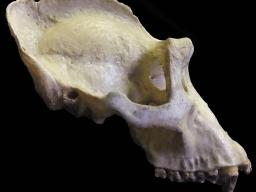
The Palaeoanthropology and Primate Evolutionary Biology Research Group aims to understand the behaviour of our extinct hominin relatives through examining skeletal and dental morphology. Our research takes a comparative focus, where we seek to interpret variation in the hominin fossil record through the use of extant comparative reference samples such as the great apes, gibbons and modern humans. Increasingly, the work of our group is moving towards “Virtual Palaeoanthropology”, that is, using 3D scanning methods (e.g. 3D surface scan,CT and microCTdata) to quantify the morphology of extinct hominins, extant primates and other mammals. We use geometric morphometric techniques to quantify morphological size and shape variation, and computational biomechanics approaches to test hypotheses of function in extant and extinct species.
Katharine Balolia’s primary research focus is to understand the relationship between sexual dimorphism in the facial skeleton and socioecological variables among extant primates, and how sex-specific patterns of adulthood growth and development relate to within-group social interactions and dominance relationships and the timing of life history events observed in primate groups. Her secondary research focus is to understand whether quantifying specific regions of the cranium and mandible using geometric morphometric techniques from data derived from 3D surface models can assist in making reliable taxonomic assessments at the genus and species level among extant primates and extinct hominins.
Laura Wilson’s research interests are centred on how the process of development has shaped morphological evolution on different time scales in mammals. Her research spans the fields of evolutionary developmental biology and biological anthropology, united through the application of statistical shape analysis and 3D modelling of hard and soft tissues to address questions that relate to adaptation, ecology and function. She uses CT, microCT and surface scan data to generate 3D models to quantify aspects of skeletal growth and development and to test biomechanical hypotheses with computational approaches (Finite Element Analysis). She has a particular interest in the ontogeny of sexual dimorphism and bone function adaptation in past populations.
Debbie Argue has a longstanding interest in uncovering the biology of Homo floresiensis and understanding its place in the human evolutionary tree. Other lab interests include understanding the relationship between endocranial variation and brain morphology among hominids, understanding the functional relationship between mandibular morphology and sagittal cresting in Gorilla and Pongo, and assessing the relationship between mandibular morphology and diet among extant extinct primates with the aim of reconstructing diet in extinct primate taxa.
We are actively looking to grow our research lab and have Honours and Masters research projects available, on cranial and mandibular anatomy of extinct hominins and their closest living relatives. If you are interested in pursuing postgraduate research in our lab, please contact Dr. Katharine Balolia (katharine.balolia@anu.edu.au) or Dr Laura Wilson (Laura.Wilson@anu.edu.au)..
Equipment
Our lab has several handheld and desktop surface scanners, a 3D printer and a large hominin and extinct primate cast collection. We have a large database of ape and modern human 3D surface scans which is available for student research projects. In addition, we have volume scans for many mammals, including microCT and diceCT (soft tissue) scans of ontogenetic series, that are available for research projects.
Research Group members:
Dr. Katharine Balolia - Lecturer in Biological Anthropology
Dr Laura Wilson – Senior Lecturer in Biological Anthropology
Dr. Debbie Argue (Visiting Fellow)
Dr. Heloisa Mariath (PhD Student)
Alannah Pearson (PhD Student)
Nicolas Brualla (PhD Student)
Kieran Baughan (Masters Student) – Working thesis title: Is mandibular shape a reliable indicator of diet in Gigantopithecus blacki?
Hannah Hooge (Honours Student) – Thesis title: Assessing the mastication hypothesis in Gorilla and Pongo: Sagittal cresting and its association with mandibular morphology.
Danielle Jeffrey (Honours Student) – Thesis title: Ancestry estimation of crania in the UNSW osteological collection through craniometric analysis
Previous Research Group Members:
Anton Nurcayho (PhD Student) – Thesis title: Geographic variation in orangutan skulls and teeth: Implications for orangutan conservation programs.
Kieran Baughan (Masters Student) – Using 3D geometric morphometrics to assess the relationship between primate mandible shape and diet (Degree Awarded 2021).
Hannah Hooge (Honours Student) – Thesis title: Assessing the mastication hypothesis in Gorilla and Pongo: Sagittal cresting and its association with mandibular morphology (Degree Awarded 2021).
Anton Nurcayho (PhD Student) – Thesis title: Geographic variation in orangutan skulls and teeth: Implications for orangutan conservation programs (Degree Awarded 2019).
Annie Backshall (Masters Student) – Thesis title: Hard to Palate: Newly identified macromorphoscopic traits of the palatine bone and their relationship to ancestry (Degree Awarded 2019).
Emma Doherty (Masters Student) – Thesis title: Geographic variation in Macaca: Implications for understanding craniofacial variation in Homo erectus. (Degree Awarded 2018).

